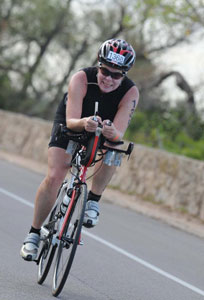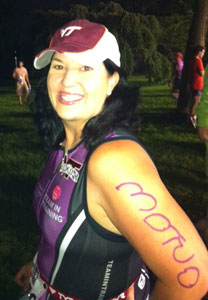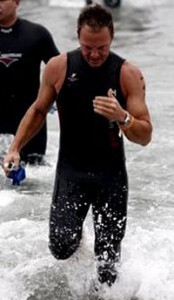The triathlon combination of swimming, cycling, and running engages muscular and cardiovascular endurance at a level unmatched by most other activities. To succeed, you need to be in shape and well prepared before the race day.
 There are hundreds of detailed training plans to help you get ready for a triathlon, written by highly qualified athletes and trainers. Elisabeth Skibba, a triathlete currently preparing for 2025’s Vineman Tri, suggests staying away from one-size-fits-all plans found online.
There are hundreds of detailed training plans to help you get ready for a triathlon, written by highly qualified athletes and trainers. Elisabeth Skibba, a triathlete currently preparing for 2025’s Vineman Tri, suggests staying away from one-size-fits-all plans found online.
“While there are many good training plans online or in books, I highly recommend working with a coach specific to triathlon. A coach can see your strengths and opportunities, offer specific advice, and tips to help improve performance.” One of her examples is for proper foot placement on the bike, which she never would have been aware of if not for her trainer. “By changing that small thing, I was able to gain more power.”
Start with a sprint triathlon
Sprint triathlons are about one-half the distance of an Olympic length event. These are a good introduction to the sport and can help you train while keeping you on track. Even if your ultimate goal is a full-length triathlon, scheduling a sprint about two months before the Olympic event is a good idea. In fact, Skibba likens it to running a half marathon prior to a full marathon.
“Every beginner should start with a sprint or short course triathlon. There is so much to learn in doing a triathlon correctly,” agrees Ria Farmer, a triathlete with almost ten triathlons under her belt who recently finished Oklahoma City’s Redman Tri. “There is more to a triathlon than just swimming, biking, and running. There is equipment, nutrition, transitions, and proper training.”
Keep equipment costs down
High-end wet suits and cycles help professional triathletes compete, but they won’t make a significant difference in your performance. Instead, if you have extra money to spend, spend it on a swimming coach. For most beginners, their swimming form is the point where they waste the most energy.
Farmer recommends “If you are doing your first triathlon then use the bike you already have, or borrow one from a friend. You have to do several triathlons to see if you even like the sport. If you do like it, then comes the time when you will need to make some decisions about equipment.”
Skibba gives a great example of this. “I knew I wanted to do Tahoe Century Ride for future; tri bikes are not allowed on that course. I wasn’t sure I was going to love the sport of tri so I purchased a road bike instead of a tri bike. I am now doing 70.3 in 2025…it can be addicting!”
Do it with a friend
 The proverb “misery loves company” definitely applies to training for a triathlon. So does the fact that training with a partner makes training more fun. It also helps keep you motivated, so you don’t skip sessions. As you know, it’s harder to stay home in front of the TV if you have to account to someone else.
The proverb “misery loves company” definitely applies to training for a triathlon. So does the fact that training with a partner makes training more fun. It also helps keep you motivated, so you don’t skip sessions. As you know, it’s harder to stay home in front of the TV if you have to account to someone else.
“When you have a friend participating with you, you have someone who understands the challenges and rewards which come with tri,” explains Skibba. “Training is intensive. You are not just training one discipline; you are training three. When you are out riding 35 miles in 100-degree-plus weather, it is nice to have someone to whine to! When you cross the finish line, it is nice to have someone who has put in the training, who has crossed the finish line, who can truly understand what the accomplishment means.”
However, for all the benefit of training with a friend, Skibba cautions that your training has to be about you, and that your training cannot sacrifice to accommodate your partner.
Don’t do too much too soon
Rather than starting at a workout duration that your body’s not ready for, begin slowly and then add distance to your training sessions. Doing too much too soon raises the risk of injury. Even if your body is ready, peaking too soon means longer workouts in the late stages of your training, which can leave your body fatigued on race day.
Practice transitions
Moving from each discipline and getting your body acclimated quickly is where most triathletes lose seconds or even minutes on their time. It’s important to include this as part of your training. Skibba’s tip: “Put your items in order that make sense. For example, glasses in helmet, helmet on top of bike shoes.”
This does not necessarily have to do with changing clothes, as in “short-course, sprint or Olympic triathlons people don’t usually change clothes,” advises Farmer. She says that the industry makes clothing that is both water resistant and aerodynamic so it’s easy to transition from each discipline. “In long course, half ironman and full ironman triathlons, there is a changing tent for changing clothes. There are USAT rules that don’t allow nudity in the transition area.”
Be race-day ready
All of this hard work pays off on race day, but only if your body is ready. Proper rest from workouts, plenty of sleep, and even your diet leading up to the race will impact your performance.
“I avoid race day fatigue by not doing anything for the two nights before the race and abstaining from alcohol,” says Robert Derow, a newer triathlete who recently completed the Malibu Olympic Tri. “I always do yoga the day before a race to make sure my body is strong and loose. I drink a ton of water the day before so my body is super hydrated.”
Derow also shared that an hour before the race he eats a bagel and banana.
Triathlons are hard. You’re going to hurt during training and on race day, and maybe even after. So don’t focus on the discomfort. Instead, think about how good it will feel to have accomplished your goal, as well as on the bragging rights you’ll have earned by finishing an elite athletic event.
Also Read:
What to Eat Before Endurance Races
Swimming Workouts for Triathlon Training
The Dirty Side of Distance Running
With contributions from Jason Brick.
